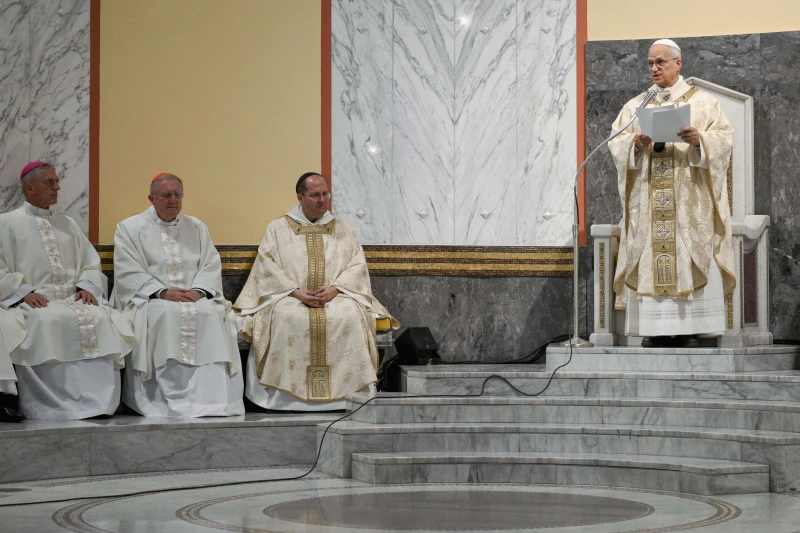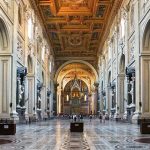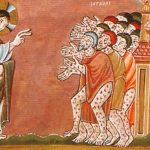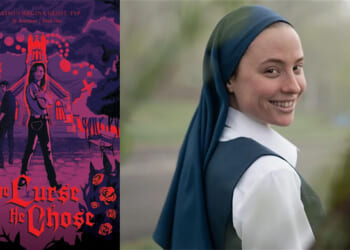 Pope Leo XIV celebrates Mass at Sant’Anselmo Church in Rome on Nov. 11, 2025, for the 125th anniversary of the church’s consecration. Sant’Anselmo Church is part of a residential college and offices of the Benedictine Confederation, the governing body of the Order of St. Benedict. / Credit: Vatican Media.
Pope Leo XIV celebrates Mass at Sant’Anselmo Church in Rome on Nov. 11, 2025, for the 125th anniversary of the church’s consecration. Sant’Anselmo Church is part of a residential college and offices of the Benedictine Confederation, the governing body of the Order of St. Benedict. / Credit: Vatican Media.
Vatican City, Nov 12, 2025 / 07:00 am (CNA).
Pope Leo XIV on Tuesday celebrated Mass at a Benedictine monastery in Rome, where he urged the monks to confront modern challenges with prayer, study, and personal holiness.
Sant’Anselmo Church, located on the Aventine Hill, was consecrated on Nov. 11, 1900. It is part of a residential college and offices of the Benedictine Confederation, the governing body of the Order of St. Benedict. Saint Anselm was a Benedictine monk and doctor of the Church.
Upon his arrival at Sant’Anselmo Church, Leo was welcomed by the Abbot Primate of the Benedictines, Jeremias Schröder, who symbolically handed over the keys of the church to the pope.
The Holy Father recalled that the church was erected at the end of the 19th and beginning of the 20th century, when Pope Leo XIII “was convinced that your ancient order could be of great help to the good of all God’s people at a time full of challenges.”
“The monastery,” he continued, “has increasingly come to be seen as a place of growth, peace, hospitality, and unity, even during the darkest periods of history.”
Turning to the present day, Leo reflected on the challenges of the modern world, which “provoke and question us, raising issues never before encountered.”
He addressed the Benedictine monks directly, inviting them to respond to the demands of their vocation by “placing Christ at the center of our existence and our mission — beginning from that act of faith that leads us to recognize in him the Savior, and translating it into prayer, study, and the commitment of a holy life.”
He urged the monks of the Aventine to become “a beating heart within the great body of the Benedictine world — with the church at its center, according to the teachings of Saint Benedict.”
“In the industrious hive of Sant’Anselmo,” he added, “may this be the place from which everything begins and to which everything returns to be verified, confirmed, and deepened before God.”
The pope also reflected on the deeper meaning of the anniversary, saying that “the Dedication marks the solemn moment in the history of a sacred building when it is consecrated to be a place of encounter between space and time, between the finite and the infinite, between man and God: an open door toward eternity, where the soul finds an answer to ‘the tension between the circumstances of the moment and the light of time, of the larger horizon […] which opens us to the future as a final cause that attracts.’”
He went on to recall the teaching of the Second Vatican Council in Sacrosanctum Concilium, a constitution on the sacred liturgy, which “describes all this in one of its most beautiful pages, when it defines the Church as ‘human and divine, visible yet endowed with invisible realities, zealous in action and dedicated to contemplation, present in the world and yet a pilgrim; […] in such a way, however, that what is human in her is ordered and subordinated to the divine, the visible to the invisible, action to contemplation, the present reality to the future city toward which we are journeying.’”
“This,” the pope said, “is the experience of our lives and of the lives of all men and women of this world — searching for that ultimate and fundamental answer that ‘neither flesh nor blood’ can reveal, but only the Father who is in heaven; ultimately, a need for Jesus, ‘the Christ, the Son of the living God.’”
At the end of his homily, the Holy Father recalled that Jesus “is the one we are called to seek, and to him we are called to bring all those we meet — grateful for the gifts he has bestowed upon us, and above all for the love with which he has gone before us.”
“Then this temple,” Leo XIV concluded, “will increasingly become a place of joy, where we experience the beauty of sharing with others what we have freely received.”
This story was first published by ACI Prensa, CNA’s Spanish-language news partner. It has been translated and adapted by CNA.












